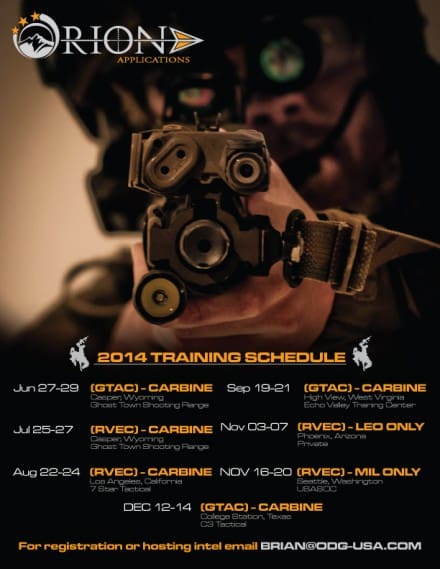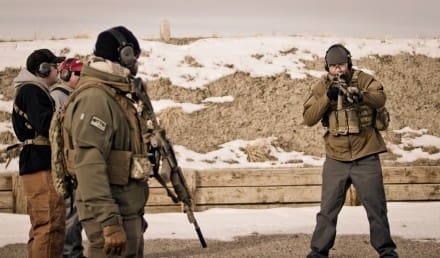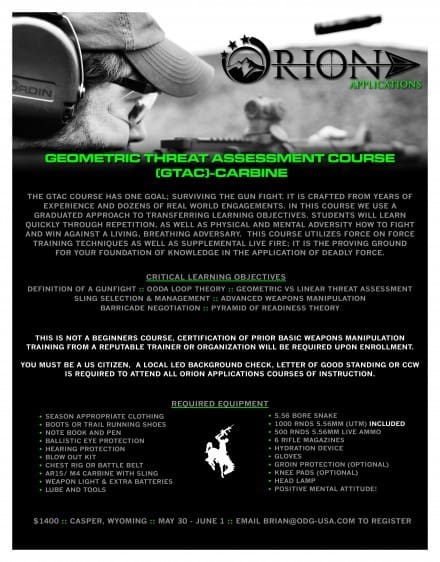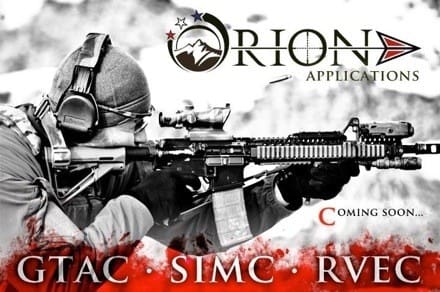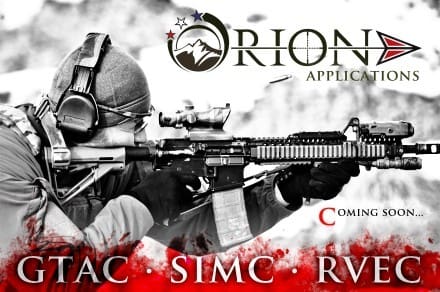This is the first guest article by Orion Applications’ Brian Bishop in a series called, “Modern Day Minuteman” where he will explore numerous topics of interest to many SSD readers.
Over the years I have constantly heard the term “Performance on Demand “. I have had the privilege of training and continuing to train with some of the best and most credible tactical trainers in the industry, some merely polished the steel on an already sharp blade and some honed a whole new edge altogether, raising my skill sets substantially.
All of them had unique and specific drills to test and measure performance on demand. Some of you may wonder what exactly performance on demand means, well simply put, on the flat range it means being able to pass a time and accuracy standard under stress. It’s a measuring stick. At that given moment do you possess the skills to succeed?
In the real world it means you either go home, or you go to the morgue.
Time after time I watched a percentage of the class fail these drills during training. Sometimes the percentage was small and sometimes it was large, but I always watched in amazement as the spectrum of men, their efforts, and their failings unfolded in front of me.
Lets take a few of the most common types of shooters that I have seen fail.
First the fat guy, he shows up and damn can he shoot accurate. He’s fast out of the holster too, but all that accuracy goes right out the window when he has to integrate movement. Once he has to run, be under stress and his heart rate spikes to 210 BPM his once shit hot static marksmanship disappears.
Next you have the skinny guy who’s in decent shape and is a decent shooter, but just gets a serious case of stage fright. He can make the time by blasting away, but shits the bed on accuracy or he’s accurate as hell, but moves slower than old people fuck.
Last but not least my personal favorite, the guy who shows up decked out head to toe in everything Crye Precision makes. These fine gentleman have the latest and greatest in weapons and kit, but the second the pressure is on and they’re in the midst of the drill, they have a malfunction and, they stop and stare at the gun like it’s got a dick growing out of the ejection port.
After watching this happen several times, at several different courses, the instructor side of me began to assess the problems these shooters had. When taken at face value the fixes were obvious and simple.
Mr. fat guy needs to go on a diet, lose weight and get in shape. Being accurate is great but, if a gun fight breaks out in the parking lot of the Piggly Wiggly and you have to sprint from cover to cover several times to close on the threat so you can neutralize it, and you arrive at the “Moment of Truth” and blow through that 8 round magazine in your fancy custom 1911 not hitting shit, congrats you get the fuck shot out of you, and die tired and still fat.
The skinny guy who chokes under pressure needs to start shooting stress drills until he becomes proficient at operating under pressure. You think it’s stressful shooting a drill on a flat range in front of 17 other guys? Wait until that nut job at the mall starts blasting away and you have bullets whizzing by you, people running and screaming around you, and dead and wounded bleeding pools of slick sticky bright red blood all over.
Last but not least, “Captain Crye”. Hey captain, great work on researching all the cutting edge high performance gear and state of the art weapon systems. I love good kit too. but put the time and training into learning simple manipulation skills and basic weapon handling fundamentals before you show up to an advanced carbine/pistol course dressed like a Ferrari that drives like a pinto.
Now all that said, I am not picking on my three examples, but rather just telling it how it is. As a matter of fact, I am proud that despite their deficiencies these men still have the balls to come out to train and better themselves. At the end of the day that’s what it’s all about, getting off the couch, grabbing your weapons and kit and learning to be a better armed citizen and shooter.
After some reflection on my own training and experiences in high stress situations, I realized that performance on demand drills are extremely important, but are usually presented in a very one-dimensional manner. Here’s a piece of steel, or an A zone on an IPSC target, or a 3”x 5” card. Shoot it, move, shoot it again, maybe throw in a reload and you have “X” amount of time.” The meaning of the drill is important in that, it’s a drill representing what I call the “Moment of Truth”. That’s the moment when a situation requiring the use of deadly force materializes out of thin air and takes a giant shit in your lap when you least expect it. Can you take the situation you have been thrust into and perform on demand to save your life, the lives of your loved ones and the lives of the innocent people around you?
These drills are great and their meaning is certainly important, however true performance on demand encompasses way more than good weapon marksmanship and manipulation skills with a sprinkle of fitness thrown in. It’s a culmination of skills that I call the “Pyramid of Readiness”.
The pyramid contains six core pieces. The first and the foundation is, education. Education is essential and where everything else stems from. Second is Mindset, as many including myself that have been stuck in some real bad situations will tell you, a strong mind will get you through anything. If you are a diehard CrossFitter and an IPSC grandmaster, but you faint or vomit at the sight of blood, it’s a bad thing and a huge hole in your readiness. Third is fitness, not only is it essential for your health, longevity, and mobility, but like my example above, if you’re overweight and out of shape it can drastically affect your performance and mindset, which in turn cripples your readiness. Fourth is marksmanship, I can’t tell you how many times I have seen shooters that don’t understand height over bore! Fifth is manipulation, an airframe helmet and jumpable plate carrier won’t save you in a gunfight if you don’t know how to clear that double feed quickly and get your gun back in the fight. Sixth, and at the top of the pyramid, is force on force. Its what I like to refer to as the “Truth Component”. It is the true test of performance on demand, and will definitely expose your readiness short falls. If you can perform successfully in a force on force evolution, chances are you will perform during the “Moment of Truth”.
Stay tuned, more to follow…….
Brian Bishop served for 8 years as an active duty Infantry NCO in the United States Marine Corps. After being honorably discharged he served an additional 5 years as a defense contractor in support of DEA and USASOC counter narcotics/FID operations. Brian has completed several combat tours in both Iraq and Afghanistan. He is currently the CEO of Orion Design Group, a leading industry design firm and the chief instructor of Orion Applications, a training group specializing in, weapons and tactics training solutions.


